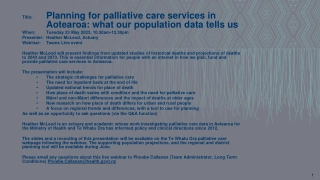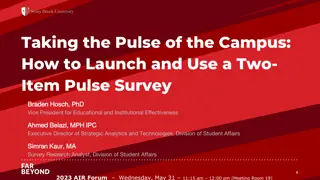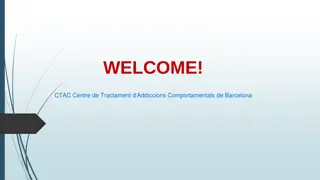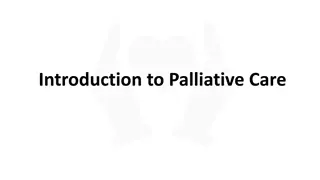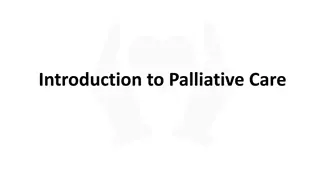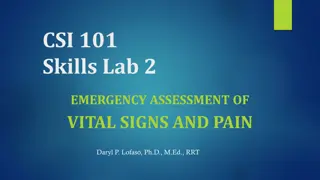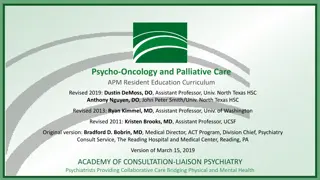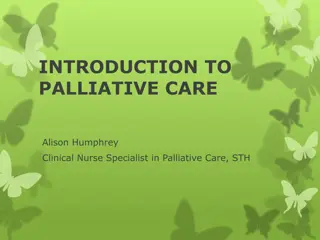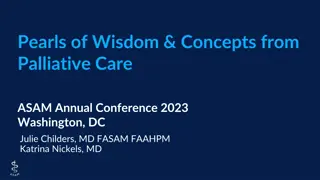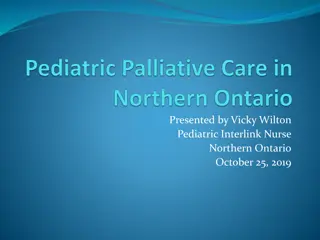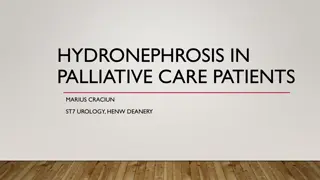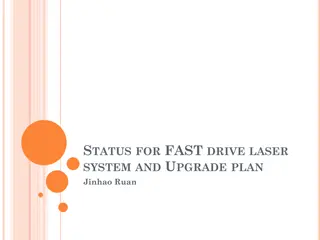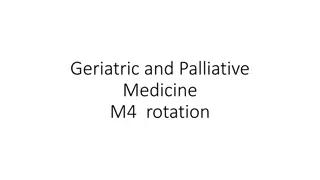
Insights from CAPC's Palliative Pulse Survey 2024
Discover key findings and voices from CAPC's first annual Palliative Pulse Survey. Learn about challenges faced by interdisciplinary teams, the importance of palliative care, and the impact on team members. Explore reasons behind the survey and its methodology, along with participant demographics and insights shared.
Download Presentation

Please find below an Image/Link to download the presentation.
The content on the website is provided AS IS for your information and personal use only. It may not be sold, licensed, or shared on other websites without obtaining consent from the author. If you encounter any issues during the download, it is possible that the publisher has removed the file from their server.
You are allowed to download the files provided on this website for personal or commercial use, subject to the condition that they are used lawfully. All files are the property of their respective owners.
The content on the website is provided AS IS for your information and personal use only. It may not be sold, licensed, or shared on other websites without obtaining consent from the author.
E N D
Presentation Transcript
Voices from the Field Findings from CAPC s First Annual Palliative Pulse Survey Brynn Bowman, MPA Andy Esch, MD, MBA Rachael Heitner, MPH, MA October 22, 2024
In Their Own Words The slow pace of educating the public that we exist. How do we support our various interdisciplinary team members without any one person or group feeling marginalized or less important? Team members are becoming isolated from each other just to accommodate the increasing patient load. Hospital staff introduce me as pre-hospice. Programs and individuals have been cut based on basic programmatic cost/revenue assessments that fail to account for palliative care's overall value to the organization. Who will take over when I am gone?
In Their Own Words Being a part of our team, which is collaborative in our approach with patients, and where all voices are equal. Watching any learner have a lightbulb moment when they see a conversation go well. Helping reduce human suffering is extremely rewarding because it helps me feel like I am making my part of the world a better place, even in small ways. I really do love the people I work with.
What is the Palliative Pulse Survey? CAPC s new, annual survey of the palliative care field How are you doing? What are you concerned about? What can we do to help?
Why the Palliative Pulse Survey? To know where we re needed we need to know what they re experiencing The Palliative Pulse is an effort to hear from as many people in the field as possible, in close to real time.
Palliative Pulse Methodology Questions were: Adapted from prior CAPC COVID-19 surveys Tested with interdisciplinary professionals across geographies The survey: Was open 3/18/24 5/6/24 Contained 29 questions, the majority multiple- choice All data is based on self-report Any member of a specialty palliative care team could participate
Participant Demographics Total Respondents: 759 16% 39% 61% 4% of respondents were from pediatric-only programs 84% Team Leader Team Member CAPC Member Non-Member
Participant Demographics Total Respondents: 759 4% 5% 22% Health System 30% South 17% 38% Hospital Midwest Hospice and HHA Northeast 24% Other West 36% 24% Physician Group
Top Three Concerns for the Next Year Team Leaders: Ability to Meet Demand (36%), Support from Organizational Leadership (36%), Access to Qualified Hires (34%) 40% 37% Team Members: Team Morale and Well-Being (44%), Ability to Meet Current Demand (38%), Support from Organizational Leadership (33%) 34% Team Morale and Well-Being Ability to Meet Demand Support from Organizational Leadership Total Respondents There was no regional variation
Top Three Concerns for the Next Year Programs led by Hospices/HHA: Billing and Coding (39%), Team Productivity (38%), Sustainable Payment Models (34%) 40% 37% Pediatric Programs: Expanding to New Patient Populations (43%), Access to Qualified Hires (39%), Team Morale and Well-Being (39%) 34% Team Morale and Well-Being Ability to Meet Demand Support from Organizational Leadership Total Respondents
Consult Request Volumes 1% Overall, almost three-quarters of respondents reported higher consult volumes compared to the previous year 43% reported much higher volumes 4% 22% Age Groups: Adult Only (71%) Pediatric Only (64%) Both (80%) Much Higher 43% Slightly Higher The Same There was little variation by administering organization or US Region Slightly Lower Much Lower 30%
Staffing Levels Overall, about one-third of team leaders reported an increase and one-quarter reported a decrease in their staffing levels Variation in staffing decreases by administering organization: Hospital: 20% Hospice/HHA: 27% Health System: 34% There was slight regional variation in staffing decreases: 25% in the Midwest vs. 36% in the West 8% 11% 20% Gained More than 25% Gained Up to 25% 23% Stayed the Same Lost Up to 25% Lost More than 25% 38%
Consult Volume vs. Staffing Levels Of the team leaders who reported an increase in consult volumes: 36% of their teams stayed the same size 27% of their teams lost staffing Palliative care professionals are doing more with less
Team Well-Being Almost all team leaders (97%) were concerned about their team s well-being to some extent 3% 17% Team leaders for programs operated by hospices/home health agencies and independent palliative organizations were slightly less concerned (94% and 91%, respectively) 20% Extremely Concerned Quite Concerned Moderately Concerned 30% Leaders of pediatric programs were slightly less concerned (92%) than those of adult or mixed age programs 30% Slightly Concerned Not at All Concerned 100% of respondents from the West Coast were concerned compared to 95% in the Northeast
Individual Well-Being 45% of all respondents reported their well- being as Excellent or Very Good 5% 12% 37% for team leaders vs. 50% for team members 17% Excellent Slight geographic variation this percentage was highest in the Northeast (48%) and lowest in the Midwest (40%) Very Good Good 33% Fair There was little variation by patient age group or administering organization Poor 33%
Program Sustainability Almost all (92%) team leaders were worried to some extent about the continued viability of their palliative care programs 8% 21% Concern was slightly lower in pediatric programs (92%) than in adult-only programs (97%) or those that treat all ages (99%) 22% Extremely Concerned Quite Concerned Moderately Concerned Slightly Concerned Not at All Concerned There was some regional variation: the Northeast had the highest concern (96%) and the South had the lowest (89%) 22% 27% There was little variation by administering organization
In Their Own Words Upper management only looks at numbers and makes decisions with no regard to how patient care will be affected. As always we don't have the staffing we would like to be able to see as many patients as fast as we would like. I'm not doing enough to keep the team's morale up and this may result in people leaving their positions. The high clinical demand makes the thought of losing team members nerve-racking.
Understanding What Palliative Care Is And Isn t Sub-Group Example Quotation Organizational Leadership I do not believe that administration understands what palliative care is. Potential Referring Providers Having to justify the need for palliative care to colleagues, convincing staff that palliative care isn't just end of life care and doesn't go around killing patients, hearing that "the family isn't ready" or "they're not dying right now." The Public The lack of resources to fund our work and the challenges that come with the general public's misunderstanding of hospice versus palliative care.
Health Equity Work Category People in Rural Areas Black or African American People without Health Insurance People with Unstable Housing Hispanic or Latino People with Developmental Disabilities 23 Count 39 30 27 25 23 Category Veterans People who Identify as LGBTQ+ People who are Incarcerated People who are Undocumented American Indian or Alaska Native Asian American or Pacific Islander Count 22 18 12 12 11 11 38% of team leaders said they were involved in general work to improve health equity 33% of team leaders said they were not currently involved in health equity work
Future CAPC Content 39% Clinical Training 26% "Emotional PPE" and Mental Health 25% Dynamics of High-Functioning Teams 23% Collaborating with Referring Providers 23% Health Equity 23% Operating Community Palliative Care Program 22% Program Measurement and Metrics 20% Billing and Coding Practices 18% Alternative Payment Models 16% Strategic Partnerships and Planning
How Far We Have Come Pulse Results 2024 Top Topics Seminar 2015 1. Team Morale and Well Being 1. Targeting and Identifying Patients 2. Discussing Prognosis 2. Ability to Meet Demand 3. Strengthening your Program 3. Support From Organizational Leadership 4. Advance Care Planning: A Central Component of Palliative Care 4. Team Well Being
The Conversation In Our Field Has Changed Future: Sustainability, consistency, accountability Now: Sustainability and growth strategies 15y ago: Making the case for palliative care
What are your national organizations doing to support this curve? Future: Sustainability, consistency, accountability Now: Sustainability and growth strategies Policy advocacy re: payment and accountability for high- quality palliative care Focus on workforce development strategies MAKING THE CASE to all audiences 15y ago: Making the case for palliative care
A CAPC Road Map the case to leadership, partnership development) Driving toward standardization and accountability for access and quality (explicit specialty palliative care requirements or incentives in population health models) Drive knowledge of palliative care and palliative approaches to care among non-palliative care health professional (including students and trainees) Raise awareness of racial inequities for people with serious illness Supporting strategic leadership (financial management, making
Broader Policy Implications Workforce needs and investment Consistent palliative care messaging Focus on equity Advancing opportunities to systematically address palliative care needs (e.g. QMs tied to relief of suffering and person-centered care) Building coalitions
55 West 125th Street 13th Floor New York, NY 10027 347-802-6231 capc.org

